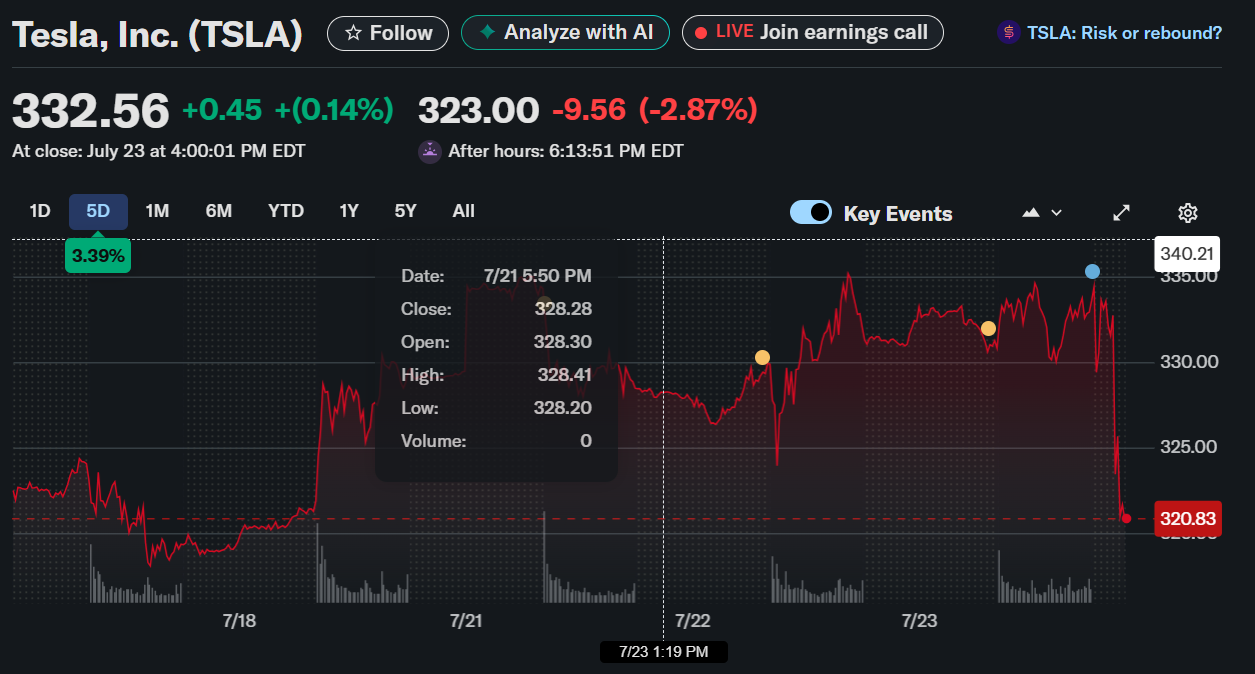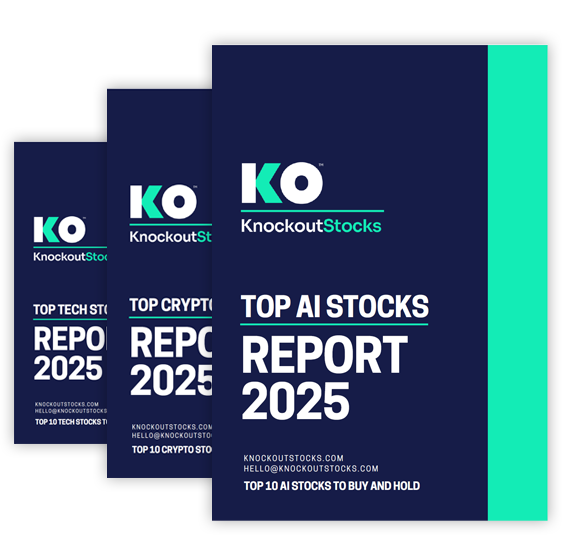TLDR
- Tesla pivots to AI, robotaxis as Q2 revenue dips 12% and profit margins tighten
- Tesla Q2: EPS hits $0.40, revenue beats but free cash flow plunges 89%
- Tesla rides AI wave, unveils robotaxi pilot despite sharp delivery decline
- Model Y shines abroad, but Tesla sees global demand slump and exec turnover
- Tesla eyes future with AI, robotics as EV sales falter and margins shrink
Tesla (TSLA) stock closed at $332.56 on July 23 but fell 2.87% to $323.00 in after-hours trading.

The company reported Q2 2025 revenue of $22.5 billion, a 12% year-over-year decline. While revenue slightly beat estimates, Tesla shifted its narrative toward AI and robotaxi services, signaling a long-term pivot.
Tesla Sees Profit Pressure Amid Revenue Slide
TSLA posted $0.40 in non-GAAP EPS, matching analyst expectations but down from $0.52 a year ago. Operating income declined 42% year-over-year to $0.9 billion, with the operating margin narrowing to 4.1%. Meanwhile, GAAP net income stood at $1.2 billion, maintaining stability despite weaker top-line performance.
Tesla Earnings Are Out
Look at these 2nd Quarter numbers:
Net income fell 16%
Free Cash flow was set at $760M…it came in at 146M
Sales are down 13.5% from last year
Revenue is down 12% from same time last yearRevenue from the automotive business fell 16%
Revenue from the…
— WTFGOP (@doggintrump) July 23, 2025
The company experienced a sharp 89% drop in free cash flow, reaching $146 million as capital expenditures surged to $2.39 billion. Tesla spent heavily on new projects and production infrastructure, contributing to tighter margins. Nevertheless, it maintained a strong liquidity position with $36.8 billion in cash and investments.
Automotive revenue dropped 16% year-over-year to $16 billion due to a 13.5% fall in vehicle deliveries. Tesla delivered 384,000 units during the quarter as demand weakened globally. However, automotive gross margin rose to 14.96% from 12.5% in the prior quarter, driven by better cost efficiency.
Robotaxi and AI Drive Tesla’s New Growth Focus
Tesla launched its first robotaxi pilot in Austin in June, a step toward its autonomous ambitions. The service currently runs with safety drivers, but the company plans to remove them once systems prove reliable. This marks the beginning of Tesla’s strategy shift toward AI-powered transportation.
Q2 2025 was a seminal point in Tesla’s history: the beginning of our transition from leading the electric vehicle and renewable energy industries to also becoming a leader in AI, robotics & related services (hi @robotaxi)
We officially launched our Robotaxi service in Austin in… pic.twitter.com/QkGO6ojybf
— Tesla (@Tesla) July 23, 2025
The firm expanded its AI infrastructure with 16,000 additional H200 GPUs at Gigafactory Texas, enhancing its training compute capacity. It now operates the equivalent of 67,000 H100 chips to support software development. TSLA also reported the first autonomous vehicle delivery to a customer using its self-driving system.
Tesla emphasized its transition into robotics and AI services alongside its electric vehicle operations. The company highlighted the strategic importance of AI and automation in long-term planning.
Tesla Expands Global Operations Despite Delivery Decline
TSLA noted strong performance across the Asia-Pacific region, with record deliveries in South Korea, Malaysia, and the Philippines. It also launched the Model Y in India, entering the world’s third-largest auto market with aggressive pricing. In Europe, Model Y remained a top seller in key markets such as Norway and the Netherlands.
The refreshed Model Y and new Model 3 received top safety ratings across multiple markets, boosting brand value. TSLA continues to prepare for the broader release of its supervised self-driving software in China and Europe. However, the global delivery slump continued to weigh on near-term results.
TSLA added 2,900 Supercharging stalls globally, growing its charging network by 18% year-over-year. Energy division revenue rose, with Powerwall deployments hitting a record for the fifth straight quarter. The company is also preparing to produce LFP battery cells in the U.S. later this year.
Executive Turnover and Public Image Remain Pressure Points
Tesla faced reputational challenges amid Elon Musk’s political activity, affecting sentiment in the U.S. and Europe. The company acknowledged key executive exits, including the departure of its sales and manufacturing head for North America and Europe. Despite these internal changes, TSLA reaffirmed its roadmap and production targets.
The company reiterated that its new low-cost model remains on track for early 2025 production. Tesla also reaffirmed its domestic battery material sourcing and manufacturing expansion plans. While delivery numbers declined, the company insists that strategic positioning and AI investments will drive the next phas






